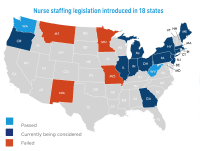It’s time to stop searching for nursing’s cost-benefit ratio and believe the data. For more than two decades, health services researchers across the United States and around the globe have found that more RN hours and a higher skill mix are positively associated with reduced mortality, shorter hospital stays, and reduced rates of pressure ulcers, falls, hospital-acquired infections, pneumonia, medication errors, and failure to rescue.
The threat of shrinking reimbursement is fueling today’s cost-reduction frenzy. Once again, as hospitals look to reduce labor costs, the laser beam focuses on nursing, which has the largest concentration of workers. What doesn’t make sense, though, is that smart hospital leaders are equally concerned about quality. After all, their survival depends on quality, as new payment incentives reward hospitals for positive outcomes and penalize them for adverse events and poor outcomes. Good quality is as healthy for a hospital’s bottom line as it is for patients. The key is to employ sufficient nurses to affect desired outcomes—not only by preventing adverse events but also by providing safe, timely, effective, efficient, equitable, and patient-centered care.
Why do many hospital leaders become amnesiac about the data their chief nursing officers (CNOs) no doubt have provided, which show higher RN hours yield better outcomes? While it’s true that more RN hours could mean higher labor costs, evidence also links more desirable RN staffing to higher RN satisfaction, lower RN turnover and overtime, and cost avoidance for adverse events—all of which reduce expenses.
A fundamental element of a positive practice environment is an adequate number of nurses with clearly defined role expectations and accountability. When too few RNs are available, too heavy a workload can have dire consequences, including missed safety checks, poor communication, and reduced patient monitoring. Continued heavy workloads can diminish staff motivation and morale, leading to higher stress and burnout—triggering a cycle of dissatisfaction and turnover. And with a high cognitive workload comes a greater risk of decision-making errors. When too few nurses are around to help each another, the safety net within a hospital unit erodes.
Of course, I know I’m preaching to the choir. So let’s get out of the choir loft and into the boardroom. Let’s start by turning our staffing data into a manual titled something like Hospital Nurse Staffing for Dummies. It can be an unexpected gift for your chief executive officer. Or perhaps start with your chief financial officer, if he or she tightly controls your organization’s purse strings. Nurse executives, managers, and staff can link arms to prepare the case for nursing hours the hospital can’t live without.
Once you’ve restored the memory of your amnesiac leaders, your CNO can elevate the discussion to the board level. Preventing harm and helping the bottom line will be music to board members’ ears. Easier said than done—I know. But if we’re not willing to put a stake in the ground, we’ll continue to plead our case for decades to come, fighting to preserve essential nursing positions in the budget every year. So let’s get nurses off the chopping block.
Here’s the outline for our proposed book:
- Prologue: Nurses are your best friends.
- Chapter 1: Data
- Chapter 2: Believe the data: Nurses are trustworthy and won’t mislead you.
- Chapter 3: Outcomes
- Chapter 4: Believe the outcomes: Safe staffing saves lives.
- Chapter 5: Impact on the bottom line
- Chapter 6: Believe the nurses; or if you don’t, walk in their shoes for a day.
- Epilogue: We’ll teach you what you need to know to achieve good outcomes and high patient and staff satisfaction.
For our part, we need to be responsible for making evidence-based staffing decisions, adjusting staffing not only when our workload increases but also when it decreases. We must show we can change based on the evidence and can innovate to create more cost-effective care-delivery models. We must adhere steadfastly to safety measures and demand the same of each nursing and interprofessional colleague. We need to collect, report, and analyze the data that will help us keep up with evaluation of appropriate staffing and outcomes. We need to hold each other accountable for care outcomes.
Let’s get writing.
Pamela F. Cipriano, PhD, RN, NEA-BC, FAAN
Editor-in-Chief


















2 Comments.
This topic is so very important. As I type, my employer is planning to icrease ratios in ICU to 3:1 (acuity not considered). PCU is 5:1 and M/S is 6-8:1. ALL patients are on telemetry in this hospital aswell. It ‘m afraid it will take a sentinel event to open the eyes on Admin., but ity will be too late. Morale is in the negatives, staff are turning into clock punchers, and nobody wants to stay at the bedside. Skilled, compassionate nurses are leaving the bedside in droves. So sad.
I love it!!! I’m tempted to print it out and take to administration today!!! But…I think I’ll let our CNO do that – she’s really good at it!